(Mark Paricio is a PolarTREC Teacher accompanying the Polaris Project this summer. To read all of Mark’s journals, go to: http://www.polartrec.com/expeditions/siberian-arctic-systems-study )
Duvannyi Yar – A Trip Back in Time
Last night after our 9:00 p.m. dinner, we all piled onto the barge hooked up to a tug boat and headed up the Kolyma River. At 1:30 p.m. just after lunch today, we arrived at a magical place – Duvannyi Yar.
The trip alone was remarkable as it was the first time since we arrived at the Northeast Science Station that we had a chance to relax for more than an hour or two. We called the trip to our “weekend” even though it was just a Thursday morning.
Duvannyi Yar is an outcrop of permafrost being eroded by the Kolyma River. Each year, the ground moves several horizontal meters toward the river and slough off, revealing new materials that have not bee seen be modern man. As such, it gives scientists a wonderful place to observe the soil profile without digging a pit or drilling a bore hole. Duvannyi Yar is also known for the numerous Pleistocene era bones that are continually being exposed as the soil erodes. Below is picture of an enormous mammoth femur found at the site.
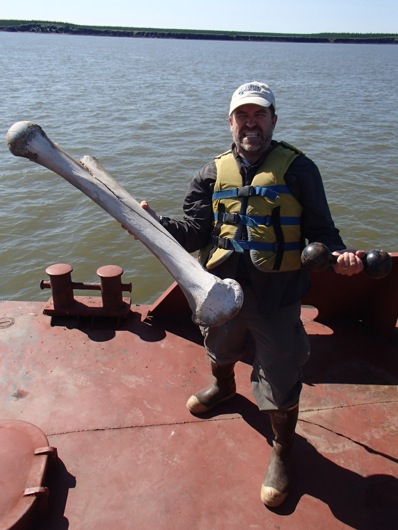
Mark does weight lifting on the barge – a mammoth femur and a dumbbell!
##Arriving at Duvannyi Yar
As the tugboat pushed to barge up against the muddy bank of Duvannyi Yar, we were warned about the deep silt we would walk across. If you stand in one place too long, you start to sink. If you sink too deep, there is no way to get your boots out of the mud, and you are forced to crawl on hands and knees like an alligator to spread your weight. Usually, your boots can be freed but not always.
To avoid this sticky situation, you either walk very quickly across the mud flats or step on any log you can find. These techniques are shown in the photos below.
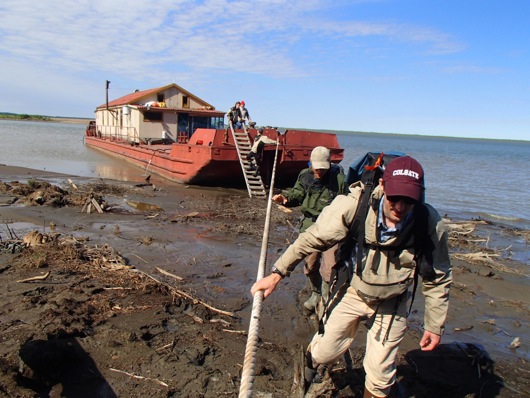
Dr. Mike Loranty of Colgate College and Logan Berner reach shore across a path of logs from the barge.
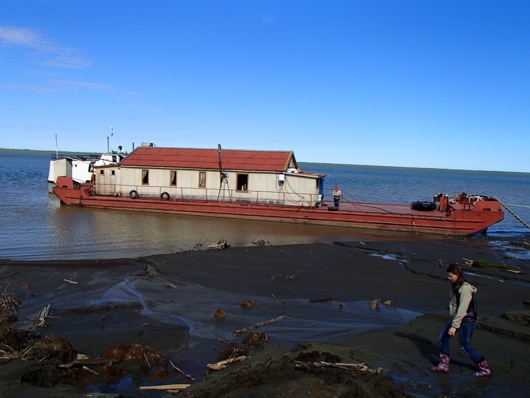
Nastya Zimova of the Northeast Science Station steps quickly across the mud flats to avoid sinking. Our mobile home, The Barge, is in the background.
Although Polaris Project students found many bones on the muddy beach, our real work was either on the face of the permafrost cliff (“Yar” is the Russian word for “cliff”; “Duvannyi Yar literally means “windy cliff,” due to the intensity of the storms that blow through the region.), at the thermokarst lake and forest above the cliffs, or in the tributary rivers nearby.
Science at Duvannyi Yar
Even before the barge arrived at Duvannyi Yar, some of the scientists (Max Holmes, Sue Natali, Dave Mayer, and Sasha Kholodov) took a speedboat farther upstream to take aquatic survey samples and to retrieve years of temperature profile data being collected at two previously drilled bore holes.
The rest of us carefully picked our way up the loose and thawing permafrost cliffs to reach the top. The photo below demonstrates the terrain we needed to climb through, using a band of grass growing up one area that slumped in a less steep incline. What the photo does not convey is that even the mounds of soil between the ice wedges are frozen and very cold. On this warm sunny day, this soil thaws into cold slippery mud that unpredictably sloughs off in small and large pieces all day. This is not a place to travel alone, so our research teams stuck together as they worked.
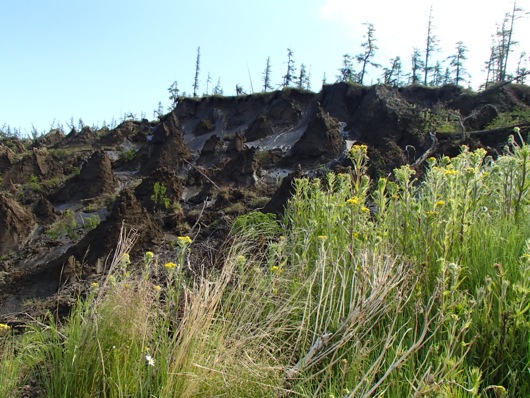
Although beautiful, the thawing permafrost cliffs of Duvannyi Yar pose considerable risk to travelers.
One group of researchers, Peter Gazlin (University of Florida) and Lindsey Parkinson (Western Washington University) made numerous biodiversity surveys of the forest above the cliffs. To do this, the randomly tossed a one-meter square of PVC piping and catalogued the plants, mosses, and lichens within the square before moving to a different location.
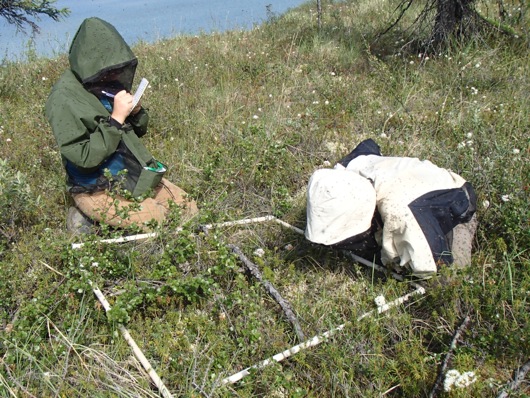
Peter Gazlin (Right) and Lindsey Parkinson conduct a biodiversity survey within the one-meter PVC Square.
Mike Loranty (Colgate College) and Vasily Lebedev (Moscow State University) set up elaborate strings of graphite electrodes to make resistivity measurements of the soils. This geophysical technique is being tested to help determine the compositions of the soils without needing to dig massive holes.
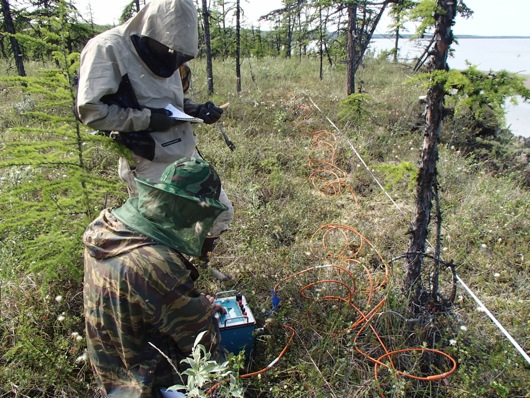
Mike Loranty (top) and Vasily Lebedev record observations from their soil resistivity experiment.
I accompanied Dr. Valentin Spektor (Melnikov Permafrost Institute in Yakutsk) and Varvara Andreeva (Northeast Federal University in Yakutsk) as Valentin rappelled off the cliff to collect dozens of samples of both permafrost soils and ice wedges at numerous depths below the cliff top. It was really hard work for him – cold, buggy, risky, slippery, and muddy. At one point he looked up and joked that no one else would want his job. In a sense, this is why it is so hard to do research in the Arctic regions. Additionally, the logistics of just getting to the field to do these difficult jobs in Siberia adds another hurdle. At least our view was spectacular!
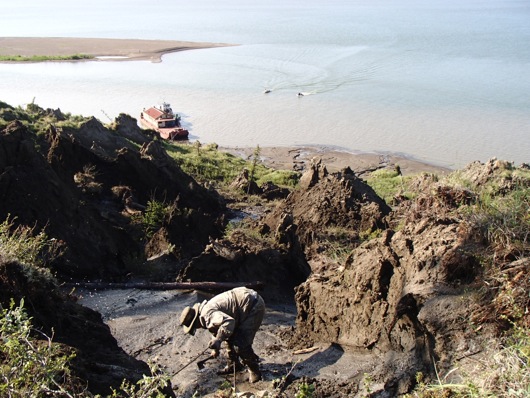
Dr. Valentin Spektor uses his axe to carve out a step in the ice from which to take samples. Below him, two of the speedboats are returning from their making aquatic measurements.
Other groups took many additional samples as well at this remarkable location. The geological history exposed at Duvannyi Yar is a rare and valuable resource to use to help gain insights on the workings of the Siberian Arctic Systems!
Stay curious my friends! – Mark Paricio




Comments(2)-
-
Gary LaRue says
July 17, 2012 at 1:20 amMark , Great photos and thanks for all the info. As a parent and as a fascinated observer I look forward to more.
Anita Hunt says
May 23, 2013 at 1:22 amIt is May of 2013, and I’ve just found your website (thanks to a lecture by Dr. Eric Scott). I will be reading your journals from now on. So, much to learn!! Thank you, Mark.